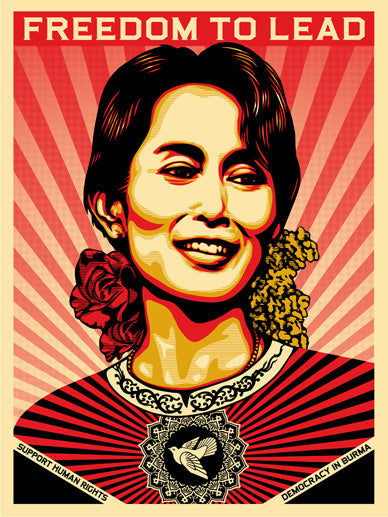
Shepard Fairey: Creator of Obama’s Hope Poster
Share
Shepard Fairey: Creator of the Hope Poster for Barack Obama - Poster Artist
Shepard Fairey was born on February 15, 1970, in Charleston, South Carolina. He developed an early interest in skateboarding and punk rock, both of which heavily influenced his later artistic style. Fairey attended the Rhode Island School of Design (RISD), where he studied illustration and first began creating street art.
Fairey’s career took off in the late 1980s with his Andre the Giant Has a Posse stickers, part of his Obey Giant project. These works became a global phenomenon, embodying themes of consumerism, authority, and propaganda. His bold, stencil-like graphics and subversive slogans gained widespread attention and solidified him as a prominent figure in the street art movement.
The Creation of the Hope Poster
The Hope poster was born during Barack Obama’s 2008 presidential campaign. Fairey, inspired by Obama’s message of hope and unity, took it upon himself to create an image that captured the spirit of the campaign. The design, featuring Obama’s portrait in red, white, and blue with the word HOPE underneath, was not officially commissioned by the Obama campaign initially.
Fairey used a photographic reference of Obama taken by Associated Press (AP) freelance photographer Mannie Garcia. He simplified the image, rendering it in his signature style, which emphasizes strong lines, sharp contrasts, and limited color palettes reminiscent of propaganda posters.
He distributed the posters at his own expense, printing thousands to plaster on walls and hand out to supporters. The artwork quickly went viral, becoming one of the most recognizable images of the campaign.
Impact and Reception
The Hope poster resonated deeply with the public. Its bold, optimistic imagery came to symbolize not only Obama’s candidacy but also a broader sense of optimism for change in America. The poster transcended political campaign art to become a cultural icon, reproduced on T-shirts, stickers, and murals worldwide.
The Obama campaign eventually embraced the artwork, and it was widely used as part of the campaign’s visual identity. Shepard Fairey’s work was praised for its emotional impact and ability to inspire grassroots engagement.
Cultural Symbolism
The Hope poster’s design is rooted in the visual language of political propaganda, which evokes both nostalgia and a sense of authority. By adopting this style, Fairey created an image that felt both timeless and modern, conveying a message of empowerment without being overly partisan.
The artwork also served as a touchstone for contemporary art’s role in politics, highlighting the power of visual imagery to shape collective sentiment. The poster became a symbol of the idealism that surrounded Obama’s candidacy.
Legal Controversy
Despite the artwork’s popularity, it sparked a legal dispute with the Associated Press (AP). The AP claimed that Fairey’s use of Mannie Garcia’s photograph constituted copyright infringement. Fairey argued that his design constituted fair use because it transformed the original image into something new and expressive.
The case was eventually settled out of court in 2011, with both parties agreeing to share rights to the image. The controversy sparked important debates about intellectual property, fair use, and the role of appropriation in contemporary art.
Shepard Fairey’s Artistic Style
Fairey’s work draws heavily on street art, punk aesthetics, and political propaganda. His influences include artists like Andy Warhol, Russian Constructivism, and the works of Barbara Kruger. The Hope poster reflects these stylistic hallmarks:
- Bold Lines and Colors: The red, white, and blue palette not only symbolized patriotism but also provided a visual punch that made the poster stand out.
- Simplification of Forms: Fairey’s artwork often reduces subjects to their most essential elements, creating powerful, easily recognizable imagery.
- Pop Art and Political Commentary: His art often fuses pop culture aesthetics with social and political messages, making it accessible to a broad audience.
The Legacy of the Hope Poster
The Hope poster remains one of the most influential pieces of political art in modern history. Its legacy extends beyond Obama’s campaign to symbolize a broader cultural and political movement.
Impact on Political Campaigns
The poster set a precedent for the role of art in political campaigns. It demonstrated how grassroots art can mobilize supporters, inspire hope, and create a unified visual identity. Future campaigns have sought to replicate this effect, often commissioning artists to produce compelling visuals.
Influence on Art and Activism
The Hope poster inspired a new generation of artists to engage with political and social issues. Fairey himself has continued to use his platform to support various causes, including environmental sustainability, racial equality, and voter rights.
The image has also been reinterpreted and parodied countless times, a testament to its enduring cultural relevance. For example, the poster’s style has been applied to other political figures, celebrities, and even fictional characters, highlighting its broad appeal and adaptability.
Conclusion
Shepard Fairey’s Hope poster for Barack Obama is more than just a piece of campaign art; it is a cultural phenomenon that captured the imagination of millions. Through bold design, Fairey distilled the essence of Obama’s message into a single, iconic image. The poster’s impact on art, politics, and culture is a testament to the power of visual storytelling.
Fairey’s work serves as a reminder that art can inspire change, unite communities, and amplify voices. The Hope poster continues to resonate as a symbol of optimism and possibility, leaving an indelible mark on both contemporary art and American history.
Links to Relevant Images
- Shepard Fairey’s Hope Poster - https://obeygiant.com/prints/obama-hope/
- Original Photograph by Mannie Garcia - https://www.nytimes.com/2009/02/11/arts/design/11fair.html
- Fairey’s Obey Giant Series - https://obeygiant.com
- Obama Campaign and Use of the Poster - https://time.com/3467411/obama-hope-poster/
- Shepard Fairey, Obey: Supply and Demand - The Art of Shepard Fairey. Gingko Press, 2006.
- Associated Press, “AP and Artist Shepard Fairey Reach Settlement,” AP News, 2011.
- Cotter, Holland. “The Artist Behind Obama’s Hope Poster.” The New York Times, February 2009. https://www.nytimes.com/2009/02/11/arts/design/11fair.html




